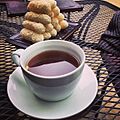Ginseng facts for kids
Quick facts for kids Ginseng |
|
|---|---|
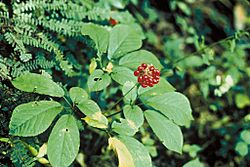 |
|
| Panax quinquefolius | |
| Scientific classification | |
| Kingdom: | |
| Division: | |
| Class: | |
| Order: | |
| Family: | |
| Subfamily: |
Aralioideae
|
| Genus: |
Panax
|
Ginseng is a special plant known for its thick, fleshy roots. It belongs to a group of 11 different plant types called Panax. These plants grow slowly and live for many years. You can find them mostly in cooler parts of the Northern Hemisphere, like eastern Asia (including northern China, Korea, and eastern Siberia). One type, Panax vietnamensis, was even found as far south as Vietnam!
Contents
Types of Ginseng
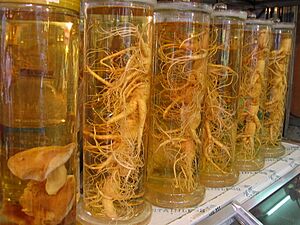
Ginseng roots are used in different ways, and they come in a few main types. These include fresh, red, and white ginseng. Wild ginseng is also very special.
Asian Ginseng
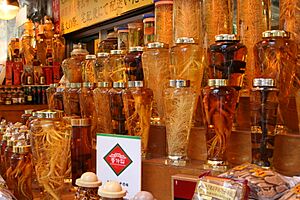
Panax ginseng is the most common type of Asian ginseng. It is sold in different forms.
Red Ginseng
To make red ginseng, the fresh root is first peeled. Then, it's heated by steaming it at 100 degrees Celsius (the boiling point of water). After steaming, it is dried, often in the sun. Sometimes, it's soaked in an herbal mix, which makes the root very brittle.
Fresh Ginseng
Fresh ginseng is simply the raw root, just as it's harvested from the ground. It's not processed in any way. You can only use it when it's available, as it doesn't last as long as dried forms.
White Ginseng
White ginseng is fresh ginseng that has been dried without any heat. It's peeled and then air-dried until most of the water is gone. If white ginseng is dried in the sun, it might lose some of its helpful ingredients. Sun-drying also makes the root a yellowish-white color.
Wild Ginseng
Wild ginseng grows naturally in forests and is collected from where it's found. It's quite rare and becoming harder to find. This is because people want it so much that they harvest it faster than new plants can grow. It takes many years for a ginseng root to become fully grown.
Wild ginseng can be either Asian or American. It can also be processed into red ginseng. Some groups are working to encourage people to plant ginseng in forests. This helps restore natural habitats and protects the wild plants that are left. These planted roots can be just as valuable as naturally grown wild ginseng of the same age.
You can plant ginseng seeds that have started to sprout from early spring until late fall. They will grow into new plants the next spring. If you plant them in a wild area and let them grow on their own, they will look just like native wild plants.
American Ginseng
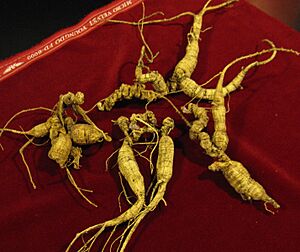
American ginseng (P. quinquefolius) is another important type. In traditional Chinese medicine, it's believed to have a calming effect on the body. It's thought to help balance your body's energy.
Most American ginseng is grown in Canada, especially in Ontario and British Columbia. It's also grown in the American state of Wisconsin. Today, P. quinquefolius is also grown in northern China.
The root of American ginseng looks a bit like a small parsnip and can fork as it gets older. The plant usually grows about 6 to 18 inches tall. It typically has three leaves, and each leaf has three to five smaller leaflets.
Images for kids
-
A root of cultivated Korean ginseng (P. ginseng)
-
Wild Korean ginseng (P. ginseng)
-
Cultivated Korean ginseng (P. ginseng)
-
Cultivated American ginseng (P. quinquefolius)
-
Fresh ginseng (P. ginseng)
-
Insam-twigim (ginseng fritters)
-
Samgye-tang (ginseng chicken soup)












